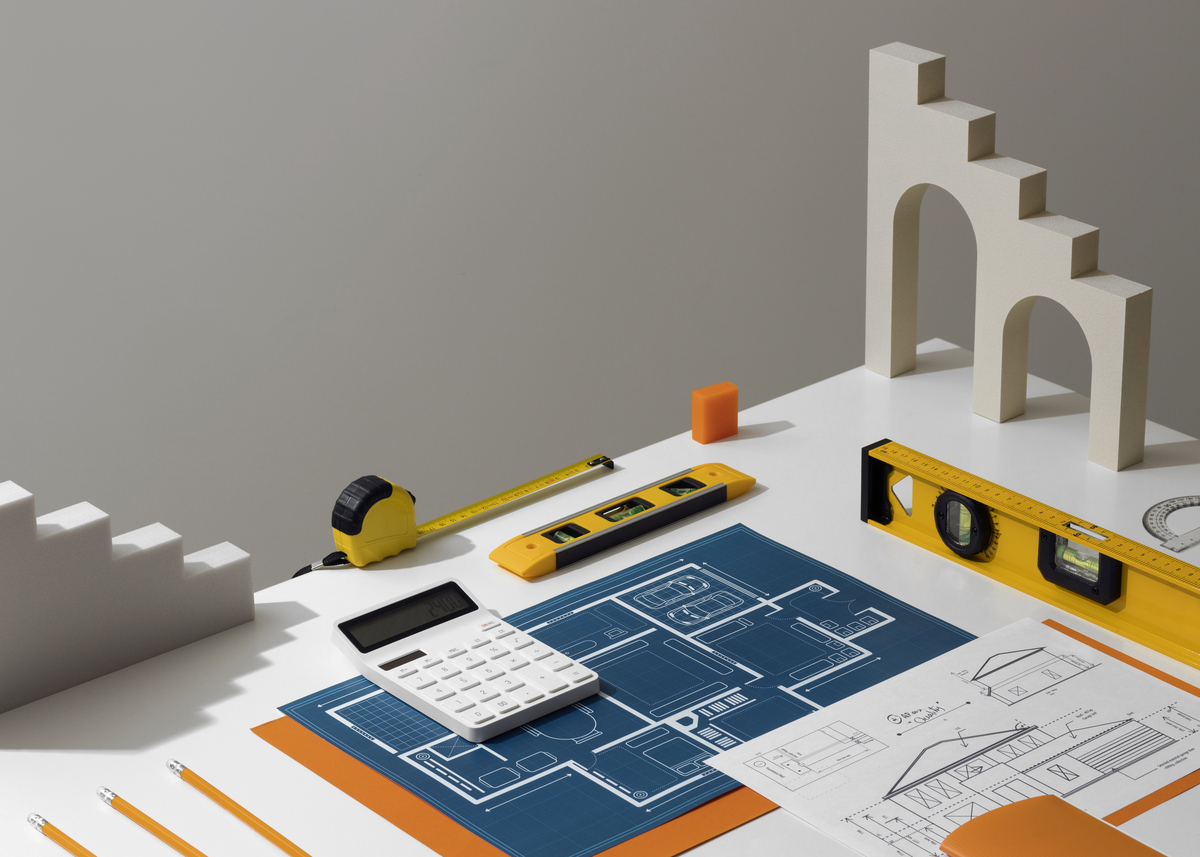The year 2025 holds great promise for the Architectural Engineering and Construction (AEC) sector, as it will be shaped by rapid technological progress, changing environmental regulations, and shifting international trade patterns.
The AEC sector, which is renowned for its adaptability and resilience, is well-positioned to adopt a variety of cutting-edge AEC industry trends that have the potential to fundamentally alter the course of infrastructure development, design, and construction in the future. A knowledge of the implications and potential of these AEC sector trends is essential for professionals, stakeholders, and fans attempting to navigate these shifts.
Comparable to a high-speed rail is the Architectural Engineering and Construction (AEC) sector. continuously changing and adjusting to the most recent developments in technology. Keeping up with the latest developments is more important than ever for AEC professionals as we approach 2025.
What precisely lies ahead, though? The Architectural Engineering and Construction environment is full of innovative possibilities, ranging from the revolutionary potential of digital twins to the revolutionary force of artificial intelligence. They vow to change the way we approach project management, building, and design.
Table of Contents
Understanding the Architectural Engineering and Construction Industry
Buildings, infrastructure, and other physical structures are the main emphasis of the Architectural Engineering and Construction (AEC) industry. The sector offers a broad range of services related to the design and development of residential and commercial projects. Experts in design and construction are involved in the planning and implementation of projects that often have budgets in the multi-billion dollar range.
It is a vital component of the economy that propels advancement and creativity in the built environment. Furthermore, the Architectural Engineering and Construction sector is a major force in forming our environment, affecting everything from the general visual appeal and cultural significance of our communities to the safety and functionality of the structures we use daily.
Architecture
The art and science of creating buildings and other tangible structures is called architecture. It is an art form that combines technical expertise and creative thinking to produce places that are both aesthetically beautiful and useful. The quality of our living and working environments is greatly influenced by architecture, which also has an impact on how we interact with one another and our surroundings.
- Challenges: Architects must strike a balance between practicality, evolving trends, and artistic expression. It is a constant effort to produce aesthetically beautiful designs within the limitations of financial resources and legal requirements. Keeping up with the latest technology developments in design tools and integrating sustainable practices further complicates matters.
- Goals: Architects want to design memorable buildings that showcase creativity and adapt to changing social demands. Aligning designs with environmental responsibility is a recurring goal of incorporating eco-friendly and sustainable aspects.
- Needs: Architects must have access to state-of-the-art design tools, chances for ongoing education, and cooperative platforms. Architects who wish to keep their licenses and numerous Architectural Engineering and Construction certifications must fulfill an annual continuing education requirement. For these experts, having access to top-notch, cutting-edge training is crucial.
Suggested article to read: How to Use AI in Architecture; Ultimate Guide for Architect in 2025
Engineering
A wide range of engineering specialties, including civil, structural, mechanical, electrical, and environmental engineering, are practiced in the Architectural Engineering and Construction sector. The technical parts of a project fall within the purview of engineers, who make sure that structures and buildings are sturdy, safe, and effective. They use scientific and mathematical concepts to address issues and come up with solutions that satisfy legal and project criteria.
- Challenges: Engineers are coping with the effects of a quickly evolving technical landscape since the introduction of artificial intelligence (AI). Other ongoing obstacles include meeting safety requirements, resolving logistical issues, and maximizing project efficiency. These worries are heightened by a scarcity of qualified engineers. This will remain a challenge because the Infrastructure, Investment, and Jobs Act (IIJA) is expected to produce approximately 82,000 engineering jobs.
- Goals: Engineering projects call for accuracy, effectiveness, and environmentally friendly methods. Modern technology and efficient procedures are the goals of engineers, who also have strict adherence to moral and ethical guidelines. Reaching goals requires a smooth working relationship with architects and construction specialists.
- Needs: There is an urgent need for training on cutting-edge technologies like artificial intelligence, access to sophisticated engineering software, and a steady stream of qualified workers. Training is crucial for engineers since, like architects, they must fulfill continuous education requirements to keep their professional licenses.
Construction
The process of bringing technical and architectural plans to life is called construction. Buildings, infrastructure, and other structures require the coordination of personnel, supplies, machinery, and technology. Professionals in the construction industry, such as contractors, project managers, and skilled craftsmen, collaborate to guarantee that projects are finished on schedule, within budget, and to the necessary quality standards.
- Challenges: Resource management, project delays, and safety issues are issues that construction companies face. Complicating matters are managing labor shortages, balancing tight budgets, and navigating regulatory compliance.
- Goals: The construction sector aims for timely project completion within budgetary constraints. Other overall objectives include embracing sustainable building practices, guaranteeing workplace safety, and implementing cutting-edge construction techniques.
- Needs: Strong safety and OSHA 10 construction training, effective project management tools, and plans to deal with the skilled labor scarcity are essential. Important factors to consider are obtaining finance, working with engineers and architects, and using sustainable methods.

The Role of AEC in Driving Economic Growth
infrastructure and structures, but it also serves as a major stimulus for more general economic activity in several important ways. First off, there are plenty of job opportunities created by the Architectural Engineering and Construction sector. The industry requires a wide spectrum of labor and talents, from architects and engineers to construction workers and project managers, which lowers unemployment and raises income levels in local areas. The vast supply chains linked to Architectural Engineering and Construction projects, encompassing everything from construction equipment to raw materials, amplify these job benefits even further in other industries.
Second, the Architectural Engineering and Construction sector creates buildings and infrastructure that are vital enablers for other industries. While commercial buildings, factories, and housing projects are necessary for business operations, manufacturing, and residential living, roads, bridges, ports, and railroads are needed for effective transportation and logistics. These facilities improve productivity and help markets run smoothly by laying the foundation for economic activity.
Furthermore, infrastructure spending is frequently viewed as a catalyst for economic expansion and recovery, particularly in times of economic crisis. Public investment in building projects has the power to boost demand, encourage private-sector investment, and boost business confidence. Because the building industry requires a large amount of domestic material inputs and is labor-intensive, the fiscal multiplier effect is especially noticeable in this sector.
The Architectural Engineering and Construction sector promotes efficiency and innovation in addition to these direct and indirect economic effects. Building Information Modeling (BIM), green building practices and smart city designs are examples of contemporary construction techniques and technologies (more on these later) that not only enhance the quality and sustainability of built environments but also promote innovation and technological advancement in other fields.
AEC Market Size and Growth
The global market for Architectural Engineering and Construction (AEC) was estimated to be worth USD 10.05 billion in 2023. From 2024 to 2032, the market is expected to develop at a compound annual growth rate (CAGR) of 10.3%, with a target value of USD 24.36 billion at the conclusion of the forecast period. The development of BIM software, the complexity of construction projects, and the expansion of the construction industry throughout different locations are the main factors driving this increase.
The market’s rise is further driven by technological integration and the growing need for eco-friendly building projects. Furthermore, obstacles including economic instability and the requirement for large initial investments can hinder growth.
Exploring 10 AEC Industry Trends in 2025
Understanding these trends is essential for navigating an exciting and demanding future in the AEC industry, regardless of experience level. Now, let’s explore the future of Architectural Engineering and Construction: a future in which innovation and pragmatism merge to create a society that is wiser, more effective, and more sustainable.
1. Emergence of Digital Twins in Construction
Imagine your construction project as a virtual model that responds and changes in real time just like the actual thing. Greetings from the world of digital twins, an idea that is quickly gaining traction in the building sector. These virtual models provide instant insights into every component of a building since they are dynamic and constantly change based on data.
Project managers and architects can anticipate problems, improve designs, and make decisions with never-before-seen efficiency thanks to digital twins. It has a significant effect, cutting costs, minimizing delays, and increasing overall efficiency. By 2025, digital twins will be a common sight in building projects, completely changing the way we design, construct, and maintain buildings.
2. Evolution in 3D Modeling
The days of 3D modeling being an exclusive tool for Architectural Engineering and Construction professionals are long gone. It is now a vital component of the sector, and in 2025 it will play an even bigger role. These days, teams may collaborate and edit in real time with advanced 3D models, regardless of where they are physically located. There will soon be integration with additional digital tools like BIM and AR, which should lead to more thorough and engaging design processes.
Suggested article to read: 11 Best Architectural Modeling Software; 2025 Review
3. Integrated Construction Project Management Solutions
Integrated project management systems are the glue that holds together the many parts of the complex construction process. In 2025, the goal is to achieve seamless integration—that is, to go beyond conventional divisions between planning and execution. Not only do platforms such as Voyansi serve as CRM software, but they also act as strong integrators and collaborators. Time is saved, misunderstandings are decreased, and an open and cooperative atmosphere are promoted by this centralized method.

4. Cloud-Based Systems: A Revolutionary Shift
By 2025, cloud-based technology are expected to revolutionize the Architectural Engineering and Construction sector. These solutions solve the long-standing problems with data storage and accessibility by providing unmatched flexibility, scalability, and collaborative options. Real-time updates and data-driven decision-making are made possible by cloud platforms, which leads to quicker project completion, lower costs, and fewer mistakes. In order to stay connected and flexible, modern AEC professionals must embrace cloud solutions.
5. Digitalizing the Building Lifecycle
The building lifetime, which has historically been viewed through a brick-and-mortar lens, is changing as a result of the digital revolution. 2025 will see a significant increase in the use of digital solutions, particularly Building Information Modeling (BIM), to manage the complexity of design and construction. Construction projects can be completed more quickly, sustainably, and affordably when BIM is used to enable a more cooperative and productive process. Throughout the building’s existence, data and innovation are used to fuel a journey of continuous improvement.
6. Augmented Reality in Construction (AR) and Virtual Reality (VR)
AR and VR are becoming commonplace tools in the Architectural Engineering and Construction business, not only for gamers and tech aficionados. By 2025, these technologies are expected to give engineering, building, and architecture a whole new perspective. By producing immersive design experiences, AR and VR can improve client happiness and help spot possible design problems early on. By encouraging better teamwork, these technologies are changing the AEC scene and producing more creative, client-focused results.
7. The Pivotal Role of Artificial Intelligence (AI) in Architectural Engineering and Construction
By 2025, AI in Architecture will have become more than just a catchphrase in the Architectural Engineering and Construction sector. The diverse range of its applications, encompassing automated design processes and predictive analytics, is transforming the way professionals approach problem-solving and decision-making. Large-scale dataset analysis, project outcome prediction, risk factor identification, and optimal solution suggestion are all made possible by AI algorithms, which also improve resource allocation and project schedules. The application of AI in the AEC sector marks a change toward more creative, intelligent, and efficient project management.
8. Embracing a Data-Driven Approach
By 2025, the Architectural Engineering and Construction sector will have quickly adopted a data-driven paradigm. Making better, more informed judgments that promote efficiency and creativity is another aspect of leveraging data, in addition to its collecting. Sites such as Voyansi are prime examples of this change, offering a thorough summary by combining information from several sources. Remaining competitive and successful in a field where accuracy and foresight are critical requires a data-driven strategy.
9. Collaboration and Communication: Imperative for Success
Collaboration and communication have always been essential in the fast-paced world of Architectural Engineering and Construction, and in 2025, they will become much more so. Digital solutions are essential for creating a collaborative atmosphere, filling in gaps, improving communication, and guaranteeing that all project participants are on the same page. For a project to be successful, real-time sharing of updates, papers, and feedback is now required rather than optional.
10. Preparing for Tomorrow: Continuous Learning and Adaptation
In the Architectural Engineering and Construction sector, change is the only constant. With 2025 in mind, it is not only advantageous but also essential to continue learning and adapting in order to remain competitive and relevant. In the future AEC landscape, professionals and companies who make training investments, try new technology, and modify their procedures to fit the newest trends will be in the forefront. Fostering an innovative and adaptable culture that can successfully manage the opportunities and challenges of the future is essential to embracing change.

Conclusion
Architectural Engineering and Construction is a team effort in which engineers enhance designs created by architects, and construction turns concepts into real buildings. The vital infrastructure of our nation, including its highways and buildings, is constructed and maintained by this sector.
The AEC sector has been undergoing continuous change due to a combination of factors such as market dynamics, sustainability requirements, and technology breakthroughs. A number of changes are expected to change the AEC landscape as 2025 approaches, impacting the planning, designing, and implementation of projects.
Now let’s examine the seven key trends that the AEC sector is predicted to see dominate in 2025. Driven by efficiency, ecological imperatives, and technology innovation, the AEC industry is poised for revolutionary shifts. Adopting these trends will put businesses at the forefront of their sector and help build more technologically sophisticated, robust, and sustainable structures. Unlocking the full potential of the Architectural Engineering and Construction business in the future will need teamwork, adaptability, and a forward-thinking approach from stakeholders navigating these changes.
digital technology and artificial intelligence (AI) are set to revolutionize the AEC industry and shape the future of architecture, engineering, and construction. The Architectural Engineering and Construction (AEC) sector is undergoing a massive transformation, and it’s all thanks to the rapid development and integration of digital technology and AI. In the coming years, we will witness unprecedented changes in the way buildings are designed, constructed, and maintained.
Suggested articles for reading:
Sustainable Construction; Comprehensive Guide 2025
Sustainable Development Goals in Construction Industry; Guide 2025
Decarbonizing Construction; A Sustainable Future Ahead (2025 Solution)
How to Use AI in Architecture; Ultimate Guide for Architect in 2025
Resources:
EnginuityAdvantage | Smart-Structures | VectorSolutions | Voyansi | Linkedin | OpenAsset | TrebleHook | Forbes | Medium
For all the pictures: Freepik



